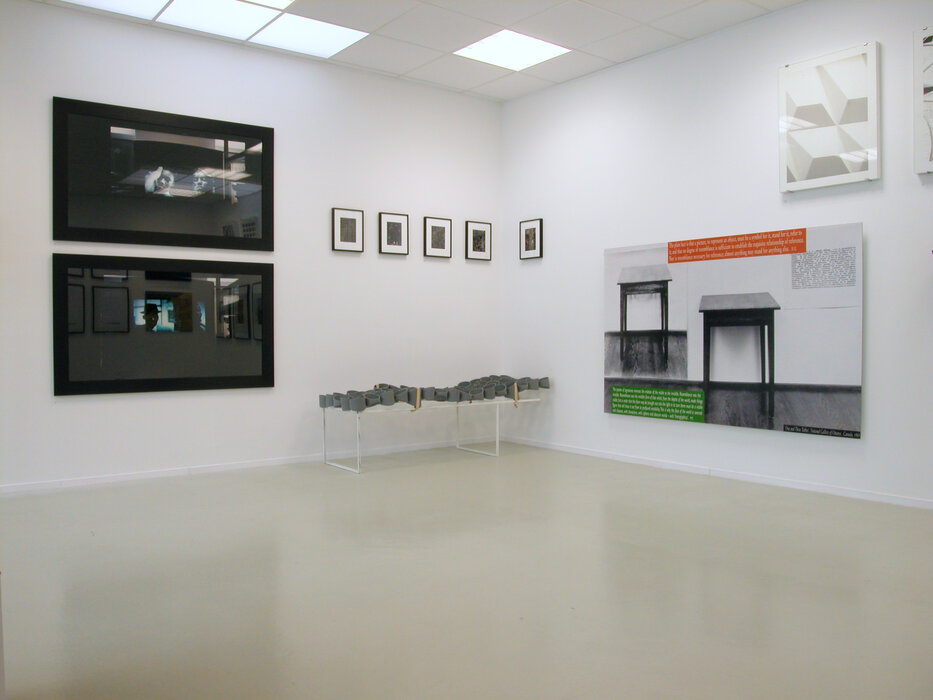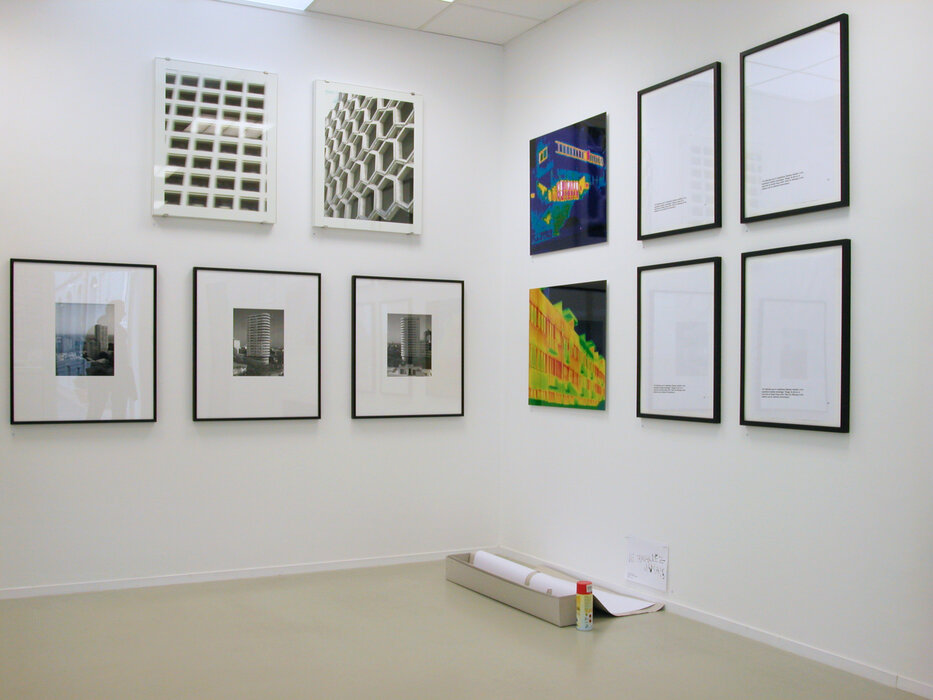Exhibition
Re-Production
23.11.2002 - 25.01.2003
Curated by Thomas Locher, Introduction Dr. Necmi Sönmez
The term “reproduction,” derived from “production,” is a rather recent term in science and philosophy. Reproduction has been an enduring component of economic theory since Marx: reproduction is socially necessary, since a social process of production is equally a process of reproduction. In analyzing the properties of industrial products, we find that they are equivalent but not identical. And reproduction is not only a repetition of production but also a self-reflexive production, a production made from products. Or so system theory claims, in any case. The relationship of product, production, reproduction, commodity, value, and meaning is a complex one. What still distinguishes the art work from the industrial commodity in this context is that the artwork is a product that aims for longevity, whereas the industrial product is ephemeral. The essential characteristic of the industrial product is its mortality. Current strategies in the production of artworks – and this has been true since the beginning of the twentieth century – make use of industrial techniques of reproduction: on a pragmatic level, existing images and texts are used reproductively. Most often they are photomechnically reproduced and/or altered using digital storage techniques. Ever since Duchamp’s readymade, the use of preexisting material has been a universal paradigm. That does not, however, mean that all available material is capable of reproduction in accordance with meaning. Everything is available, but everything does not have equal value. In the realm of profane commodity objects and of the profane images of the mass media, one has to choose very carefully. The interesting thing is that the objects or illustrations that are chosen to be reproduced or placed into another context are imputed with a hidden, unconscious value. This value is rescued by this move into the other cultural context (e.g., a museum), and it ascribes to the artist the special competence of having recognized precisely this unconscious element. The reason that this fictional construction is so successful is that the commodity object has already achieved the state of a natural object, and theoretically we can no longer draw an exact boundary between nature and thing, between image and subject.
In communication theory, the relationship of the message to its reproducibility is a system, since when sending messages the unforeseen must be avoided if the message is to be understood. Sending something as something new presumes a change in the code. This is complicated in two respects: either the message will not reach its receiver or understanding the message will take a very long time. Duchamp is a good example here. The reception of messages can be delayed, but this delay should not last all that long. Because, in the present-day economy, the commodity must be immediately recognized as commodity. Anything else would be unproductive. Another solution would be to alter the code violently and abruptly in a quasi revolutionary situation. That too is complicated, so the sender dispenses with unusual messages and sends the familiar. Fact: the receiver must in principle be able to recognize every possible message.
Reproductive technologies are not simply an enduring component of artistic production; it may be that the production of art does not exist outside the framework established by technology. Artistic production that wants to see itself as not reproductive is thus already contaminated by the reproductive element. Moreover, that an artifact has been reproduced is a necessary proof of its existence: if the artwork does not exist within the media of observation as a reproduction, it does not exist at all. The presumption that the artifact loses its singular value in the process of reproduction has been reversed: only mass media reproduction assures the artwork of its place in the archives and warehouses of cultural memory (according to Boris Groys) and legitimizes its existence there. And it is only a clear placement within these archives that makes the question of value, meaning, and survival possible at all. The ideological reassessment of objects to artifacts, from profane pictorial quality to sublime visuality – all processes of acquisition, appropriation, and deconstruction of materials already archived elsewhere are processes that have been reflected on in theory and criticism only inadequately. An ultimate theory of production/reproduction has yet to be developed. Nor can it or will it be achieved here. In essence, the production of art today is the transfer of objects from among various storage places: from one cultural context to another, from one warehouse to another. Back and forth, up and down.
Works by:
Pash Buzari, Raphael und Tobias Danke, Eva Grubinger, Markus Huemer, Kathrin Kaps, Markus Keibel, Joseph Kosuth, Thomas Locher, Ines Lombardi, Rudi Molacek, Stephen Prina, Gerwald Rockenschaub, Stefan Römer, Aldo Runfola, Pietro Sanguineti, Heidi Specker, Haim Steinbach, Rudolf Stingel, Rirkrit Tiravanija, Rolf Walz, Christopher Williams, Peter Zimmermann
The term “reproduction,” derived from “production,” is a rather recent term in science and philosophy. Reproduction has been an enduring component of economic theory since Marx: reproduction is socially necessary, since a social process of production is equally a process of reproduction. In analyzing the properties of industrial products, we find that they are equivalent but not identical. And reproduction is not only a repetition of production but also a self-reflexive production, a production made from products. Or so system theory claims, in any case. The relationship of product, production, reproduction, commodity, value, and meaning is a complex one. What still distinguishes the art work from the industrial commodity in this context is that the artwork is a product that aims for longevity, whereas the industrial product is ephemeral. The essential characteristic of the industrial product is its mortality. Current strategies in the production of artworks – and this has been true since the beginning of the twentieth century – make use of industrial techniques of reproduction: on a pragmatic level, existing images and texts are used reproductively. Most often they are photomechnically reproduced and/or altered using digital storage techniques. Ever since Duchamp’s readymade, the use of preexisting material has been a universal paradigm. That does not, however, mean that all available material is capable of reproduction in accordance with meaning. Everything is available, but everything does not have equal value. In the realm of profane commodity objects and of the profane images of the mass media, one has to choose very carefully. The interesting thing is that the objects or illustrations that are chosen to be reproduced or placed into another context are imputed with a hidden, unconscious value. This value is rescued by this move into the other cultural context (e.g., a museum), and it ascribes to the artist the special competence of having recognized precisely this unconscious element. The reason that this fictional construction is so successful is that the commodity object has already achieved the state of a natural object, and theoretically we can no longer draw an exact boundary between nature and thing, between image and subject.
In communication theory, the relationship of the message to its reproducibility is a system, since when sending messages the unforeseen must be avoided if the message is to be understood. Sending something as something new presumes a change in the code. This is complicated in two respects: either the message will not reach its receiver or understanding the message will take a very long time. Duchamp is a good example here. The reception of messages can be delayed, but this delay should not last all that long. Because, in the present-day economy, the commodity must be immediately recognized as commodity. Anything else would be unproductive. Another solution would be to alter the code violently and abruptly in a quasi revolutionary situation. That too is complicated, so the sender dispenses with unusual messages and sends the familiar. Fact: the receiver must in principle be able to recognize every possible message.
Reproductive technologies are not simply an enduring component of artistic production; it may be that the production of art does not exist outside the framework established by technology. Artistic production that wants to see itself as not reproductive is thus already contaminated by the reproductive element. Moreover, that an artifact has been reproduced is a necessary proof of its existence: if the artwork does not exist within the media of observation as a reproduction, it does not exist at all. The presumption that the artifact loses its singular value in the process of reproduction has been reversed: only mass media reproduction assures the artwork of its place in the archives and warehouses of cultural memory (according to Boris Groys) and legitimizes its existence there. And it is only a clear placement within these archives that makes the question of value, meaning, and survival possible at all. The ideological reassessment of objects to artifacts, from profane pictorial quality to sublime visuality – all processes of acquisition, appropriation, and deconstruction of materials already archived elsewhere are processes that have been reflected on in theory and criticism only inadequately. An ultimate theory of production/reproduction has yet to be developed. Nor can it or will it be achieved here. In essence, the production of art today is the transfer of objects from among various storage places: from one cultural context to another, from one warehouse to another. Back and forth, up and down.
Works by:
Pash Buzari, Raphael und Tobias Danke, Eva Grubinger, Markus Huemer, Kathrin Kaps, Markus Keibel, Joseph Kosuth, Thomas Locher, Ines Lombardi, Rudi Molacek, Stephen Prina, Gerwald Rockenschaub, Stefan Römer, Aldo Runfola, Pietro Sanguineti, Heidi Specker, Haim Steinbach, Rudolf Stingel, Rirkrit Tiravanija, Rolf Walz, Christopher Williams, Peter Zimmermann

